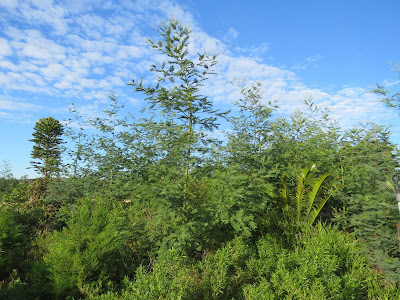Australia's Black Wattles a flight hazard in China
Australia's Black Wattle may soon become a problem for planes flying through China. Not because the trees will grow tall enough to interfere with flight paths, but because they rather like growing in airports and birds like to roost in them.
We grow Black Wattle (Acacia mearnsii; not the unrelated Callicoma serratifolia which New South Welshman tend to call Black Wattle) in the Australian Garden at Cranbourne Gardens (above) as a quick growing screen for other plantings - in this case, with other wattles, in the Gondwana Garden.
Scientists in China, however, are worried that our Black Wattle is spreading so quickly through open landscapes such as those surrounding runways, that it may soon be a problem for aviation and local biodiversity. The airports are in Yunnan Province, in the southwest of China, including the Kunming Changshui International Airport (below, by Min Liu) where many Australian botanists and plant collectors have arrived to help document and bring into propagation Chinese plants.
Wattles have been planted deliberately in many countries to to improve soil (like most legumes, wattles bringing with it bacterial nodules that fix nitrogen and make it available for other plants and organisms), and for timber, adhesive and tannin production.
The bark of Black Wattle contains a chemical useful for tanning leather and has been grown for this purpose in places such as Brazil, China and many South African countries. In fact the extracted tannin is exported back to Australia.
That's all good but the Black Wattle is also in the top 100 of the world's worst invasive alien species. The seeds are notoriously long-lived, and spread by rodents and birds, and often locals moving the plant around for firewood. Black Wattle is fast growing, 'fixes' its own nitrogen, doesn't mind a bit of salt in the soil and likes growing in disturbed areas.
The native (largely non-human assisted) range of Black Wattle is southern Australia - from around Hobart through to half way up the New South Wales coast - and its human assisted range now extends to Western Australia, North America, South America, Asia, Europe, Pacific Islands, Africa and Europe. In fact, as Neville Walsh reminded me (based on his memory of a discussion with Jim Ross, ex-South African and ex-Chief Botanist at Royal Botanic Gardens Victoria), the species was named after an American collector, Edgar Mearns, who found the plant growing in Kenya and other parts of East Africa in 1909.
Time for a breather. To refocus at a finer scale for a moment, if you are trying to separate Black Wattle (top picture above) from Silver Wattle (Acacia dealbata; bottom picture) look closely at the fern-like leaves. Black Wattle has green rather than silvery leaves - it is sometimes called, helpfully, the Green Wattle.
Black Wattle also has a different arrangement of raised 'glands' (the pimples with dots in the pictures above). You find them at or near the feathery leaf junctions as well as in between some of them. Be careful though. The number of in-between glands is variable, and sometimes there are none. Helpfully though compared to the Silver Wattle the glands in Black Wattle tend to not line up as well with the feathery off-shoots.
Black Wattle also has a different arrangement of raised 'glands' (the pimples with dots in the pictures above). You find them at or near the feathery leaf junctions as well as in between some of them. Be careful though. The number of in-between glands is variable, and sometimes there are none. Helpfully though compared to the Silver Wattle the glands in Black Wattle tend to not line up as well with the feathery off-shoots.
Now, back to China. It isn't so much that the Black Wattle will grow close enough to the runway to irritate pilots on take off and landing, although that must be one concern. The main problem, it seems, is an increase in 'bird strikes' (i.e. birds getting sucked into bits of a plane where we'd rather they didn't) due to more roosting places.
How this wattle managed to become a flight hazard in Kunming is explained deeper in the paper. Prior to 2007, the airport was reclaimed land, once used for villages, farmland and planted forests. The latter included Black Wattle as a planted species and it's assumed there are extensive seed banks of the species in the soil.
The climate around Kunming is very similar to southern Australia, which is why botanic gardens such as those of Sydney and Melbourne have sent expeditions to this area to collect suitable garden plants such as camellia species.
Finally, plane movements themselves can move seeds around the airport land and then when new buildings or runaways are constructed, such activities break the dormancy of the seed.
So all up this is another example of how by manipulating nature we can inadvertently cause ourselves a heap of problems. That's putting aside the local plants and animals that might be displaced. However with Fred Pearce's voice still reverberating in my head, I should note that at least 34 Chinese bird species live in and near the Black Wattle and may well thrive in its presence. That's if they stay clear of passing jet engines.
Images: all pictures other than at Kunming airport and the close of a Silver Wattle leaf (from near the Yarra River at Hawthorn) are from the Australian Garden, Cranbourne Gardens, part of the Royal Botanic Gardens Victoria.
Images: all pictures other than at Kunming airport and the close of a Silver Wattle leaf (from near the Yarra River at Hawthorn) are from the Australian Garden, Cranbourne Gardens, part of the Royal Botanic Gardens Victoria.






Comments